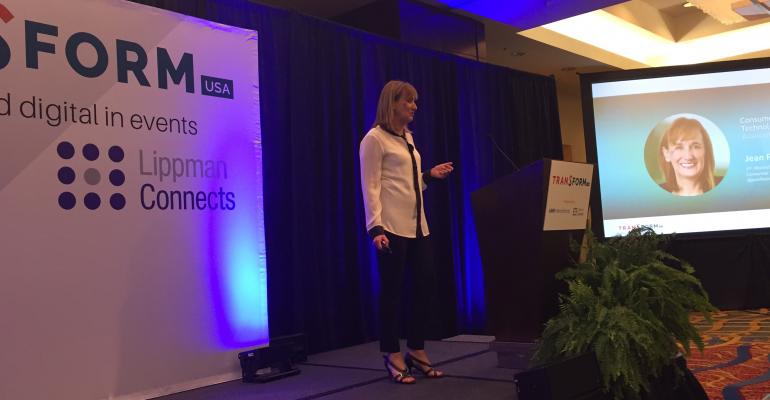Today’s chief marketing officers have a lot more distribution channels than they used to back in the days when print and broadcast media were the main competitors for an exhibition organizer’s marketing budget. Not only is the market changing with social and digital competitors vying for their share of marketing dollars, chief marketing officers themselves have had to develop a new way of approaching their work, said Jean Foster, vice president of marketing with the Consumer Technology Association during her keynote address at Transform USA, held in Washington, D.C., this summer.
“The CMOs are changing,” she said, and savvy exhibition organizers need to change along with them. “Today’s CMO has to be part marketing genius, have a creative skill set, understand data, and be enough of a data scientist to be able to leverage that data into action.” Before coming to CTA—which organizes CES, the monster global consumer electronics and consumer technology tradeshow in Las Vegas—Foster was CMO of information security and risk management solutions provider Ostendio. She said she wasn’t all that interested in trade shows until “I realized that this industry has data that marketers would kill for.”
Digital Transformation
While trade shows are still a vital piece of the marketing pie—people still want to get together and learn from each other, she said—“We have to transform to stay relevant.”
With 62 percent of adults consuming news on social media, and one in four adults in the U.S. finding content through predictive technology such as Netflix and Amazon recommendations, that transformation has to be digitally focused. “We used to put print ads out there and hope the message was right. Not anymore.” Now CMOs want to be able to immediately measure the impact of what they’re doing and shift on the fly to maximize the marketing impact. That means data analytics, she said. If you can’t show exhibitors the data on what they’ll get in return for their investment in your show, “they will easily cut exhibiting at your trade show from their budgets.”
She added, “Having data, and being able to use it effectively at a moment’s notice to make a business case, is a tool every organizer needs to have to survive.”
Foster outlined this six-step plan event organizers can use to set their digital strategy to attract and retain today’s CMO customer:
Step 1: Understand your clients. What are their goals? How do you measure those goals?
Step 2: Know your data. Think about where that data resides, she said. “It’s probably in many systems—beacons, registration, the event app.” You also need to know what legal, security-related, and privacy obligations you have related to that data. The sheer volume of available data can be overwhelming, she acknowledged. The best way to start is by mapping out what you have, and then evaluate to see where your low-hanging fruit may be. You may want to start with registration data, for example, to begin targeting people by job title to personalize your marketing efforts.
Step 3: Set your roadmap. Foster said many trade show organizers are in the process of putting their digital marketing roadmap in place now. Some questions to ask, she said, are: “What are you going to do to get the data into a usable format? What tools do you need? What skills and talents do you need? That’s going to be one of the biggest challenges.”
Step 4: Focus on the attendee experience before, during, and after the event. Citing the spread of technology similar to Disney’s MagicBand wristband, which seamlessly manages the user experience, to a Carnival Cruise Line ship, it’s now easier than ever to see what people are doing, make recommendations on what they may want to do next, and follow up with them post-experience, she said. “People are willingly giving you more data than most marketers have.” How can you provide a Carnival Cruise–like experience for your participants?
Step 5: Leverage technology. “This is absolutely key,” she said. By now, most people are familiar with artificial-intelligence–directed recommendations provided by companies such as Netflix and Amazon. How can you make recommendations based on the data your participants are providing?
Step 6: Share with customers. Provide valuable data back to your clients and help them make the case for ROI.
“This is an industry full of data,” said Denzil Rankine, executive chairman of AMR International, which co-organized Transform USA with Lippman Connects. “We just have to learn how to harness it” and turn it into actionable decision-making criteria for today’s CMO customer.





